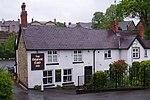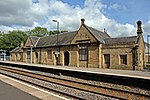Ruabon
Communities in Wrexham County BoroughPages with Welsh IPARuabonVillages in Wrexham County BoroughWards of Wrexham County Borough

Ruabon (Welsh: Rhiwabon; pronounced [r̥ɪʊˈɑːbɔn]) is a village and community in Wrexham County Borough, Wales. The name comes from Rhiw Fabon, rhiw being the Welsh word for "slope" or "hillside" and Fabon being a mutation from St Mabon, the original church name, of earlier, Celtic origin. An older English spelling, Rhuabon, can sometimes be seen. In 2001, more than 80% of the population of 2,400 were born in Wales, with 13.6% having some ability in Welsh.
Excerpt from the Wikipedia article Ruabon (License: CC BY-SA 3.0, Authors, Images).Ruabon
Tan Y Llan,
Geographical coordinates (GPS) Address Nearby Places Show on map
Geographical coordinates (GPS)
| Latitude | Longitude |
|---|---|
| N 52.986 ° | E -3.039 ° |
Address
Tan Y Llan
Tan Y Llan
LL14 6BU , Ruabon
Wales, United Kingdom
Open on Google Maps





